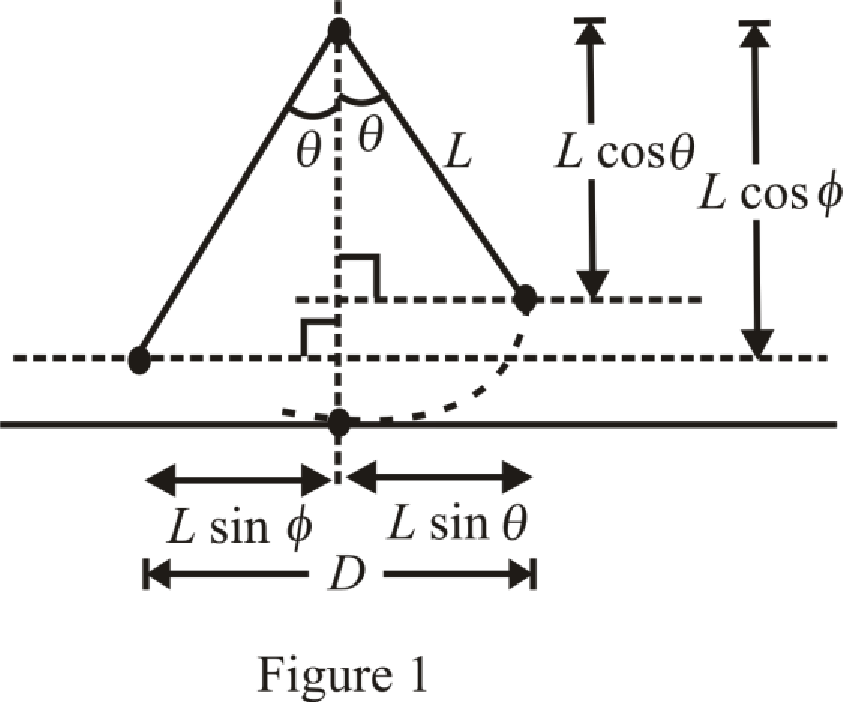
Concept explainers
(a)
The minimum speed with that Jane begins her swing to just make it to another side.
(a)
Answer to Problem 81CP
The minimum speed with that Jane begin her swing to just make it to other side is
Explanation of Solution
Consider the horizontal motion of Jane, as shown in figure (I) Jane moves from initial point to final point on the other side.

Write the expression for the total horizontal distance
Rearrange the above expression.
Simplify the above expression.
Here,
Consider the body-string-earth system as a non-isolated system. Since there is a force acting on the vine in a positive horizontal direction.
Write the equation for conservation of energy.
Here,
Write the equation for the change in potential energy
Simplify the above expression as.
Here,
The height can be calculated as shown in figure (I) from the equilibrium point.
Substitute
As the body moves with an initial speed and final speed of the body is zero.
Write the expression for the change in kinetic energy as.
Since the body moves with an initial speed and final speed of the body is zero. As the final speed of the body is zero than final the kinetic energy becomes zero.
Substitute
Here,
Write the expression for work done by wind as.
Here,
Substitute
Rearrange the above equation.
Simplify the above equation.
Conclusion:
Substitute
Substitute
Thus, the minimum speed with that Jane begins her swing to just make it to the other side is
(b)
The minimum speed with that Jane and Tarzan begin their swing to just make it to the other side.
(b)
Answer to Problem 81CP
The minimum speed with that Jane and Tarzan begin their swing to just make it to other side is
Explanation of Solution
Consider the body-string-earth system as a non-isolated system. Since there is a force acting on the vine in a positive horizontal direction.
The height can be calculated as shown in figure (I) from the equilibrium point.
Substitute
Since the body moves with an initial speed and final speed of the body is zero. As the final speed of the body is zero than final the kinetic energy becomes zero.
Substitute
Here,
Write the expression for work done by wind as.
Here,
Substitute
Rearrange the above equation.
Simplify the above equation.
Since the total mass of the system is the mass of Jane and Tarzan.
Conclusion:
Substitute
Thus, the minimum speed with that Jane and Tarzan begin their swing to just make it to the other side is
Want to see more full solutions like this?
Chapter 8 Solutions
Physics for Scientists and Engineers with Modern, Revised Hybrid (with Enhanced WebAssign Printed Access Card for Physics, Multi-Term Courses)
- A 480 g peregrine falcon reaches a speed of 75 m/s in a vertical dive called a stoop. If we assume that the falcon speeds up under the influence of gravity only, what is the minimum height of the dive needed to achieve this speed?arrow_forwardH4. An m=60 kg diver jumps off a diving board h=3 m above the water that acts like an ideal spring with k=1.2 kN/m after being bent a total of y=50 cm. How far below the water does the diver reach without swimming if the resistance force of the water is a constant R=30 N and they are at a θ=25° from the vertical angle? Ignore air resistance. A student, m=75 kg, is pushed by two springs, k1=1.5 N/m, k2=2.5 kN/m through a frictionless slope, h=10 m, until the θ=30° incline which has µk=0.15. How far, x, along the incline will the student go?arrow_forwardTarzan grabs a vine of length L=8.9 m and attempts to swing across the crocodile infested river. The vine breaks just as Tarzan is at lowest point of his swing, a horizontal distance D=60 m and H= 4.5 m above the riverbank. You barely mix it across, landing on the edge of the riverbank. The tension in the vine when it broke was a 1000 N. Find Tarzan's mass.arrow_forward
- A 77.1-kg circus performer is fired from a cannon that is elevated at an angle of 52.1° above the horizontal. The cannon uses strong elastic bands to propel the performer, much in the same way that a slingshot fires a stone. Setting up for this stunt involves stretching the bands by 2.62 m from their unstrained length. At the point where the performer flies free of the bands, his height above the floor is the same as that of the net into which he is shot. He takes 2.30 s to travel the horizontal distance of 20.1 m between this point and the net. Ignore friction and air resistance and determine the effective spring constant of the firing mechanism. Number i Unitsarrow_forwardA slingshot consists of a Y-stick and a light leather cup containing a stone. The cup is pulled back against two parallel rubber bands. It takes a force of 15 N to stretch either one of these bands 1.0 cm. With what speed does the stone leave the slingshot?arrow_forwardTendons. Tendons are strong elastic fibers that attach muscles to bones. To a reasonable approximation, they obey Hooke’s law. In laboratory tests on a particular tendon, it was found that, when a 248-g object was hung from it, the tendon stretched 1.22 cm. (a) Find the force constant of this tendon in N/m. (b) Because of its thickness, the maximum tension this tendon can support without rupturing is 140 N. By how much can the tendon stretch without rupturing, and how much energy is stored in it at that point? Draw free-body diagram.arrow_forward
- A 69.1-kg circus performer is fired from a cannon that is elevated at an angle of 48.2 ° above the horizontal. The cannon uses strong elastic bands to propel the performer, much in the same way that a slingshot fires a stone. Setting up for this stunt involves stretching the bands by 3.58 m from their unstrained length. At the point where the performer flies free of the bands, his height above the floor is the same as that of the net into which he is shot. He takes 2.16 s to travel the horizontal distance of 20.5 m between this point and the net. Ignore friction and air resistance and determine the effective spring constant of the firing mechanism. Number i Unitsarrow_forwardTendons. Tendons are strong elastic fibers that attach muscles to bones. To a reasonable approximation, they obey Hooke’s law. In laboratory tests on a particular tendon, it was found that, when a 250 g object was hung from it, the tendon stretched 1.23 cm. (a) Find the force constant of this tendon in N/m. (b) Because of its thickness, the maximum tension this tendon can support without rupturing is 138 N. By how much can the tendon stretch without rupturing, and how much energy is stored in it at that point?arrow_forwardA bowling ball is suspended from the ceiling of a lecture hall by a strong cord. The ball is drawn away from its equilibrium position and released from rest at the tip of the demonstrator’s nose as shown in Figure CQ8.5. The demonstrator remains stationary. (a) Explain why the ball does not strike her on its return swing. (b) Would this demonstrator be safe if the ball were given a push from its starting position at her nose?arrow_forward
- A 100 kg one-man bobsled starts from rest 50 m from the end of an icy, 15° slope. A giant 2.0-m-long spring is placed against a barricade at the bottom of the slope. (Figure 1) shows a coordinate system with the origin at the base of the spring. The bobsled brake fails to work, and the sled crashes into the spring. The spring compresses 75 cm before expanding and shooting the bobsled back up the slope. What is the spring constant of the spring? Figure 15° 1 of 1 -Xarrow_forwardA bungee cord is rated at 545N/m. The jump is off a bridge above a river. Unstretched, the bungee cord is 68.0 m long. A 72.0 kg person jumps. They fall till and the cord begins to stretch. Find the amount by which cord has stretched when the person’s speed is 14.0 m/s.arrow_forward7.43 - A 2.0-kg piece of Figure P7.43 wood slides on a curved surface Wood (Fig. P7.43). The sides of the surface are perfectly smooth, but the rough horizontal bottom is 30 m long and has a kinetic friction coefficient of 0.20 with the wood. The piece of wood starts from rest 4.0 m above the rough bottom. (a) Where will this wood eventually come to rest? (b) For the motion from the initial release until the piece of wood comes to rest, what is the total amount of work done by friction? Rough bottomarrow_forward
 Principles of Physics: A Calculus-Based TextPhysicsISBN:9781133104261Author:Raymond A. Serway, John W. JewettPublisher:Cengage Learning
Principles of Physics: A Calculus-Based TextPhysicsISBN:9781133104261Author:Raymond A. Serway, John W. JewettPublisher:Cengage Learning
